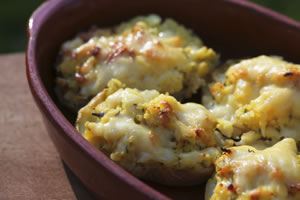In its plainest form the baked potato is devoid of pomp and splendour; it is the furthest you could go from “nouvelle cuisine”. Yet it is a lip-licking moment when jacket potatoes are removed from the bonfire ashes – soft and brown, with a fluffy, creamy interior perfect for lapping up lashes of butter or a pile of grated cheese.
The ‘hot potato’ has become a metaphor for juggling with those tricky issues that are essential yet we can’t quite face – and the spud has a history that suits the reputation.
When the potato arrived in Europe in the late 1500s, it was initially regarded with suspicion. In South America, cultivated for thousands of years, it was a staple, but to Europeans it was unknown. Most people regarded the bulbous beige tuber as fit only for animals.
It took two centuries for potatoes to be taken seriously as food. One story has it that Frederick the Great of Prussia saw its potential but had to use reverse psychology, planting fields of potatoes and stationing a guard around them, to convince locals that something important was being grown.
A similar stunt was arranged by Antoine-Augustin Parmentier, who popularised the potato in France, having first eaten them when a prisoner of war in Hamburg. To overcome a French law against cultivating potatoes, he staged such publicity coups as persuading Marie Antoinette to wear a potato flower. On the other side of the Atlantic, potatoes spread slowly through the northern colonies, but it was only when Thomas Jefferson served them at the White House that they began to gain popularity.
As Charles Darwin would later observe, the potato could grow in more diverse climates than other foods; and during wars, when crops above ground could be trampled by soldiers, the potato was protected. Further, a food that did not require threshing and grinding fuelled the need for easy meals of a working population that was moving into and expanding cities during the Industrial Revolution.
By 1800, the potato had found its role as a convenience food – easy to prepare or to buy ready-cooked – and began to appear in recipe books. Britain’s population was increasing rapidly, and some say this would not have happened without the potato, which helped to reduce the effects of diseases such as scurvy, tuberculosis and dysentery. The combination of higher birth rates and lower mortality travelled with the potato wherever it became a regular part of the popular diet, and nowhere more so than in Ireland.
There was a shadow side to this. By the 1840s, almost half the Irish population had become dependent on just a couple of high-yielding varieties. When a blight caused by the fungus Phytophthora infestans took hold, farms and homesteads were soon left with the stinking remains of blackened and rotting tubers. As a result about a million Irish people died and a million emigrated, reducing the population by a fifth.
This tragedy reminds us of the necessity to maintain a diversity of crops. Diversity has iterations on many other levels, from ecosystem health to social, cultural and personal health. We need a balance of different foods to maintain a nutritional balance. In today’s language, we need our “five a day” – and the potato alone is not enough. We also need to hold on to valuable legacies: had the Irish practised the Incan art of drying and storing potatoes against harvest failure, they might have fared better.
Potatoes are good sources of vitamin C and vitamin B6. They are high in potassium, manganese, phosphorus, niacin and pantothenic acid. They contain phytonutrients and, served on their own, are fat-free and fairly low in calories, with 110 calories per medium-sized spud (a nickname derived from the narrow spade used to dig them up).
Nutritionally, however, potatoes lack calcium, vitamin A and vitamin D, and are not high in protein. They supply more nutrients than any other easily grown plant, however, so they can provide more nutritious food from less land. The fibre they possess is largely in the skin, with most of the vitamins occurring just below; for this reason baking is the best way to cook them, as it avoids water-soluble nutrients leaching out, or excess fats being added as with frying.
Potato skins can be harmful if boiled and eaten in huge quantities, though you would need to eat 10–50 potatoes in one sitting to experience the negative effects of the toxic chemicals (glycoalkaloids and phenols) present in the form of solanines. The home truth that any green should be removed from the potato is borne out by research, since doing so also removes the risk of solanine poisoning.
Another issue is the high level of carbohydrate in the potato. This helps maintain good levels of glucose in the blood. However, this is carbohydrate that the body digests rapidly, which can lead to surges and dips in blood sugar and insulin – the nightmare of the diabetic.
Interestingly, Rudolf Steiner’s cautionary comments about the potato back in the 1920s provide a precursory echo of these findings: “When we eat potatoes, we really get a longing to eat something again quite soon. The potato will soon make us hungry again because it does not go all the way to the head… Someone who eats a lot of potatoes does not get powerful thoughts; but he’ll get dreams that make him heavy. And someone who has to eat potatoes all the time will get really tired…and always want to sleep and dream.”
Another cautionary note about potatoes relates to their storage. They are the most important food NOT to keep in the fridge, where potato starch is converted into sugar, which when baked or fried can combine with the amino acid asparagine and produce the chemical acrylamide, thought to be harmful.
The art of the skilled juggler of food is one to master, and once we have done so, we need never worry whether our metaphorical potatoes are hot or cold – we can simply enjoy a changing variety of foods: fresh, cooked, fermented, raw; starch, protein, fibre, fat; autumn, winter, spring, summer. Within this variety, the potato well deserves its place. Hail, brother potato!
TWICE-BAKED POTATOES
The following recipe is an easy way to make an old favourite just a little bit fancier. Baked, stuffed and baked again, these scrumptious potato halves provide a satisfying meal that can be served with salads or whatever greens the season offers.
Serves 6
6 medium baking potatoes (about 1.5kg)
4 eggs *
1 onion or leek (about 200g)
1–2 tbsp olive oil
1 tsp dried herbs – thyme, mixed herbs, etc.
1 small courgette (about 150g)
1 tbsp lemon juice or cider vinegar
200g cheddar cheese*
50g smoked cheddar cheese*
2–3 tbsp fresh parsley, chopped finely
1–2 tbsp capers, chopped (optional)
1 tbsp Dijon or grainy mustard
125ml sour cream or yoghurt*
2 tbsp pumpkin, sesame or sunflower seeds (optional)
sea salt to taste
freshly ground black pepper to taste
* For non-dairy diets, leave out the cheese and sour cream. Vegans can also replace the eggs with 170g cooked red lentils.
1. At least 3 hours before serving time, scrub the potatoes and spread them out on metal baking trays. Preheat the oven to 200°C. Jab the potatoes in several places with a skewer and bake for up to 1½ hours. Turn over after 40 minutes to ensure even cooking. They are ready when they are soft to squeeze and a knife will plunge through easily. It’s important to test all the potatoes for softness, as they seem to possess an annoying habit of getting ready at different rates!
2. Cover the eggs with cold water. Bring to the boil and simmer vigorously for 10 minutes. Drain and plunge into cold water (reputed to prevent a grey layer forming around the yolk).
3. As soon as the potatoes are cool enough to handle, halve them lengthwise. Scoop out most of the inside of each, leaving the skin sitting intact, like a boat, with only a thin layer of potato still supporting the shell. Place the potato pulp in a bowl, and line up your fleet of potato boats in lightly oiled baking dishes.
4. Crack and peel the hard-boiled eggs – leaving them in the cold water while you peel them helps the shells slip off more easily, as water will seep under the shell and loosen it. Chop small.
5. Finely chop the onion or leek. Sauté in olive oil with a pinch or two of salt and the dried herbs. Grate the courgette and add it to the softening onion after 5 minutes. Stir in the lemon juice or cider vinegar and cook for a couple more minutes.
6. Grate the cheeses and mix them together. Set one third aside, ready to go on top of the potato halves later.
7. Mash the potato with a fork or a masher. Mix in the chopped parsley, onion mixture, chopped capers and mustard. Add the sour cream/yoghurt, two-thirds of the grated cheese, and the chopped eggs, and mix well. Adjust the seasoning to taste with salt, pepper and mustard.
8. Now use the filling to stuff the potato shells, pushing the mixture well to the edge and heaping it up. Sprinkle the top with the remaining grated cheese, followed by pumpkin, sesame or sunflower seeds if desired.
9. Place the stuffed potatoes in the oven and bake for about 30 minutes at 180°C. When ready they should be hot through, with the cheese melting temptingly and beginning to turn golden brown.







